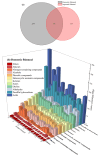Evaluation of Dynamic Changes of Volatile Organic Components for Fishmeal during Storage by HS-SPME-GC-MS with PLS-DA
- PMID: 38731661
- PMCID: PMC11083336
- DOI: 10.3390/foods13091290
Evaluation of Dynamic Changes of Volatile Organic Components for Fishmeal during Storage by HS-SPME-GC-MS with PLS-DA
Abstract
Headspace solid-phase microextraction, combined with gas chromatography-mass spectrometry and partial least squares discriminant analysis, was adopted to study the rule of change in volatile organic compounds (VOCs) for domestic and imported fishmeal during storage with different freshness grades. The results showed that 318 kinds of VOCs were detected in domestic fishmeal, while 194 VOCs were detected in imported fishmeal. The total relative content of VOCs increased with storage time, among which acids and nitrogen-containing compounds increased significantly, esters and ketones increased slightly, and phenolic and ether compounds were detected only in domestic fishmeal. Regarding the volatile base nitrogen, acid value, pH value, and mold counts as freshness indexes, the freshness indexes were significantly correlated with nine kinds of VOCs (p < 0.05) through the correlation analysis. Among them, volatile base nitrogen had a significant correlation with VOCs containing nitrogen, acid value with VOCs containing carboxyl group and hydrocarbons, pH value with acids which could be used to adjust pH value, and mold counts with part of acids adjusting pH value and VOCs containing nitrogen. Due to the fact that the value of all freshness indexes increased with freshness degradation during storage, based on volatile base nitrogen and acid value, the fishmeal was divided into three freshness grades, superior freshness, corrupting, and completely corrupted. By using partial least squares discriminant analysis, this study revealed the differences in flavor of the domestic and imported fishmeal during storage with different freshness grades, and it identified four common characteristic VOCs, namely ethoxyquinoline, 6,7,8,9-tetrahydro-3H-benzo[e]indole-1,2-dione, hexadecanoic acid, and heptadecane, produced by the fishmeal samples during storage, as well as the characteristic VOCs of fishmeal at each freshness grade.
Keywords: HS-SPME-GC-MS; PLS-DA; correlation analysis; fishmeal; freshness.
Conflict of interest statement
The authors declare no conflicts of interest. The funders had no role in the design of the study; in the collection, analysis, or interpretation of data; in the writing of the manuscript; or in the decision to publish the results.
Figures







Similar articles
-
Study on VOCs of Fishmeal during Storage Based on HS-SPME-GC-MS.ACS Omega. 2024 Jul 17;9(30):32817-32827. doi: 10.1021/acsomega.4c03323. eCollection 2024 Jul 30. ACS Omega. 2024. PMID: 39100347 Free PMC article.
-
Analysis of Potential Markers of Pork Freshness Based on Volatile Organic Compounds.Foods. 2025 Feb 28;14(5):832. doi: 10.3390/foods14050832. Foods. 2025. PMID: 40077535 Free PMC article.
-
Discrimination and screening of volatile metabolites in atractylodis rhizoma from different varieties using headspace solid-phase microextraction-gas chromatography-mass spectrometry and headspace gas chromatography-ion mobility spectrometry, and ultra-fast gas chromatography electronic nose.J Chromatogr A. 2024 Jun 21;1725:464931. doi: 10.1016/j.chroma.2024.464931. Epub 2024 Apr 22. J Chromatogr A. 2024. PMID: 38703457
-
Discrimination and Characterization of the Volatile Organic Compounds in Schizonepetae Spica from Six Regions of China Using HS-GC-IMS and HS-SPME-GC-MS.Molecules. 2022 Jul 8;27(14):4393. doi: 10.3390/molecules27144393. Molecules. 2022. PMID: 35889268 Free PMC article.
-
[Recent advances in the application of headspace gas chromatography-mass spectrometry].Se Pu. 2018 Oct 8;36(10):962-971. doi: 10.3724/SP.J.1123.2018.05013. Se Pu. 2018. PMID: 30378354 Review. Chinese.
Cited by
-
Elucidating Volatile Flavor Profiles and Metabolic Pathways in Northern Pike (Esox lucius) During Superchilled Storage: A Combined UPLC-Q-TOF/MS and GC-MS Approach.Foods. 2025 Jul 22;14(15):2556. doi: 10.3390/foods14152556. Foods. 2025. PMID: 40807493 Free PMC article.
-
Investigation of the differences in volatile organic compounds of sesame oil under different processing methods using GC-IMS and electronic nose.Front Nutr. 2025 Aug 1;12:1611006. doi: 10.3389/fnut.2025.1611006. eCollection 2025. Front Nutr. 2025. PMID: 40823037 Free PMC article.
References
-
- Geng J., Liu J., Kong X.R., Shen B.S., Niu Z.Y. The fishmeal adulteration identification based on microscopic image and deep learning. Comput. Electron. Agr. 2022;198:106974. doi: 10.1016/j.compag.2022.106974. - DOI
-
- Zhao J.Y., Ye Y.T. Sensory evaluation of fishmeal and statistical analysis of fishmeal index. Feed Ind. 2018;39:59–64. doi: 10.13302/j.cnki.fi.2018.10.013. - DOI
-
- Li P., Niu Z.Y., Zhu M., Shao K.Y., Geng J., Li H.C. Analysis of Volatile Compounds in Fish Meal Based on SPME-GC-MS and Electronic Nose. T Chin. Soc. Agr. Mach. 2020;51:397–405. doi: 10.6041/j.issn.1000-1298.2020.07.045. - DOI
-
- Wu D.W., Tang F., Hu B., Ye Y.T. The impact of different raw materials and dying methods on the quality of fish meal. Feed Ind. 2020;41:29–34. doi: 10.13302/j.cnki.fi.2020.04.006. - DOI
Grants and funding
LinkOut - more resources
Full Text Sources
Miscellaneous

